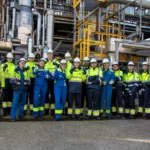Advanced Materials: A strategic pillar to guide the chemical industry’s competitiveness and double twin transition

Cefic recognises the European Commission’s recent publication of its Strategy on Advanced Materials for Industrial Leadership as a pivotal step towards addressing the challenges posed by the green and digital transition. The Strategy aims to speed up research and technology in advanced materials, boost innovation and manufacturing capacities, and accelerate the industrial uptake of these materials.
Advanced materials are essential for providing solutions to today’s societal challenges, including the crucial reduction of greenhouse gas emissions. Their role across various sectors is instrumental in improving technologies such as making the production of electricity more energy-efficient with higher efficiency photovoltaic materials.
The chemical industry, as the primary source of advanced materials’ value chains, is at the forefront of pioneering innovations.
Dr. Daniel Witthaut, Executive Director for Innovation at Cefic, states, “The chemical industry’s capacity for innovation is instrumental in designing advanced materials with new functionalities. This leads to the development of new products, applications, and even value chains.”
Witthaut further underlines the importance of the next generation of advanced materials, “These will be designed with circularity and sustainability aspects in mind, such as recyclability, driving the green and digital transition and boosting Europe’s industrial leadership.”
Cefic underlines critical areas to ensure the success of this strategy:
- Funding: The European Commission has pledged to boost capital investment and finance for advanced materials in general. In particular, the European Commission targets €500 million for 2025-2027 for a new co-programmed public-private partnership (PPP) “Innovative Advanced Materials for EU”, with at least €250 million expected from private sources. While Cefic appreciates this initiative, we stress that this amount falls short of what is necessary to significantly speed up the development of advanced materials for the green and digital transition, crucial for maintaining the EU’s industrial leadership. Several additional EU Research & Development funding sources are mentioned, which, as a general rule, should be easier and quicker to access than is the case today.
- Support for Public-Private Partnerships (PPPs): The effectiveness of PPPs in Horizon Europe highlights their importance in driving innovation. The Advanced Materials PPP (IAM4EU) now in development for Horizon Europe’s final three years, should be prioritised for inclusion in Framework Programme 10 (FP10).
- Scale-up: High relevance needs to be given to funding of technology scale-up, taking technological developments efficiently and coherently from the lab to industrial production and, eventually, to consumer market applications.
Aligned with the Antwerp Declaration for a European Industrial Deal, Cefic advocates for a European Industrial Deal, underlining the chemical industry’s commitment to Europe’s transformation. Cefic is ready to continue collaborating with stakeholders to maximise the potential of advanced materials, ensuring the chemical industry plays its role in making Europe competitive, resilient, and sustainable.











